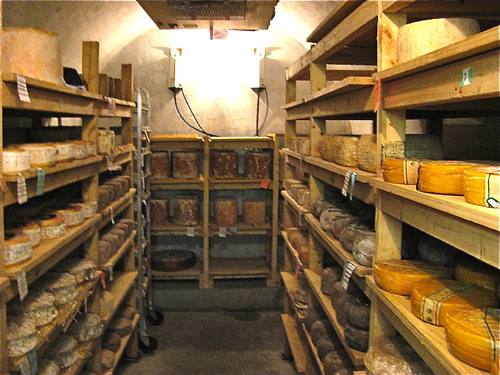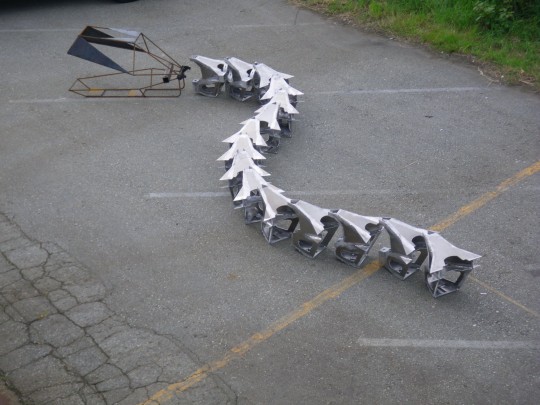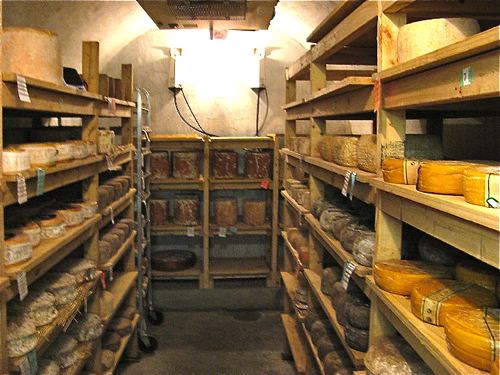 A cheese cave at Murray’s CheesePhoto: VIPNYCAging cheese is tricky business. Trust me, I saw some pretty gory casualties while working at Murray’s Cheese in New York City this summer. When cheese goes wrong, it’s subject to cracking, peeling, excessive amounts of mite-dust, saggy skin, hosts of unintended molds. The list goes on.
A cheese cave at Murray’s CheesePhoto: VIPNYCAging cheese is tricky business. Trust me, I saw some pretty gory casualties while working at Murray’s Cheese in New York City this summer. When cheese goes wrong, it’s subject to cracking, peeling, excessive amounts of mite-dust, saggy skin, hosts of unintended molds. The list goes on.
Which is why I was surprised to read about people who think of affinage, the process of carefully aging cheese, as a joke, or worse, a scam. The New York Times published a great article recently called “Cheese: A Coming-of-Age Story.” It featured many big names in the American cheese scene, including Rob Kaufelt, the owner, and Brian Ralph, the cave manager at Murray’s Cheese, a bastion of great cheese. They talked about why it matters to pay attention to temperature, humidity, ambient microorganisms , and storage when aging cheese. Doing it well, they said, produces that perfect bloomy-rinded Valençay, or that glossy, amber-hued Epoisses, while doing it carelessly (or not doing it at all) can lead to disaster, or at the very least some pretty underwhelming curd.
In the same article Steven Jenkins, the cheesemonger at Fairway, a local supermarket chain, calls affinage “a total crock.” He added: “if my humidity is 35 percent different from yours, my cheese is going to taste just as good as yours. It may have a different color of mold on it, but it’ll taste just as good. And yours is going to be twice as expensive, and you’re a highway robber. And you’re contributing to the preciousness and folly of Americans trying to emulate something in France that has nothing to do with quality.”
As anyone who has kept a bit of chèvre in the fridge for too long can attest, Jenkins is blatantly wrong. Obviously the environment and method of storage are crucial to the quality of the cheese. What’s more, affinage is hardly just trendy French fluff – it has been practiced for countries across Europe for generations. In most cases, it is the difference between a mere lump of milk curds and a character-filled gastronomic delight.
Don’t get me wrong, affinage can definitely go wrong. Though like any process of fine-tuned experimentation (cheese itself is the result of accident), there will always be failures, indeed many more of them than successes. But this is hardly a reason to write off the whole endeavor as a hoax to ruthlessly relieve us of our food budget.
What I find most intriguing about this alleged ‘controversy’, however, is the underlying cultural attitude that gives rise to such tendentious opinions. The suspicion of anything French, for example; that anything French is necessarily “fussy”, and therefore bad, not to be trusted. It also presupposes – like so much of the recent backlash against foodie-ism — that any food crafted with a high attention to detail should not be trusted.
The thing is: all cheeses, except for those eaten fresh, undergo aging. That is what brings them to maturity. I can’t help but question a position to the contrary, in the same way it makes no sense to say all wines are created equal, or all vegetables, or any food product at all, regardless of the knowledge, care, and effort of the producer.
Ultimately, the cheese speaks for itself. The New York Times tasting panel preferred aged cheeses from Murray’s hands down over those from Fairway. Meanwhile, in a Diner’s Journal follow-up to the original article, Mr. Jenkins criticises the “foodie” who spends “$14 for [unaged goat’s cheese] that Fairway’s got for $4.49”, and still doesn’t seem to understand what affinage actually is. If a chèvre is $14, it’s going to be because of factors other than affinage. After all, the cheese is fresh.
But affinage is still only one stretch of the road from milk to cheese and, like most foods, can only be as good as its ingredients. An aged cheese can only be as good as the land and environment it comes from. While the affineur manages closed systems to achieve a specific result, the producer navigates a network of open systems and must be in touch with forces largely uncontrollable, like seasonality: virtually all cheeses change over the course of the year as the diets of the animals shift between fresh pasture, mature plants, hay, and other feed sources. And that’s not even getting into breed type, lactation and milking patterns, or terroir. Good affinage, I would argue, is not only about careful attention to the cheese when its in the cave, but also a keen understanding of where it comes from. Affinage can enhance the subtleties of the production stage and bring them to the forefront of the tasting experience. A good affineur should be able to give you a summer version and a winter version of the same cheese and floor you by both their similarities and their marked contrast.
So production and refinement are very much bound up in each other. But I wanted to test affinage, or the lack of it, for myself. To settle the matter once and for all, I bought a small round of fresh goat’s cheese from Vermont Butter and Cheese, for an experiment. Left in each of the five caves at Murray’s (each is kept at different temperature and humidity conditions, and contains different molds), this small disc would form into five very different cheeses — some of them revelatory, some less so. After a week of careful aging in my refrigerator, I am proud to report, the best I could do was some yellow slime, a chalky texture, and a brisk sour reek.




